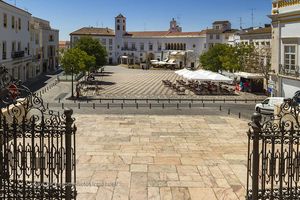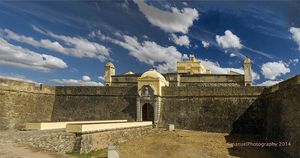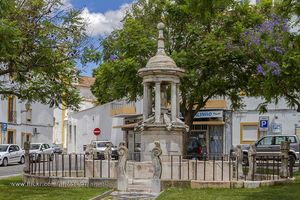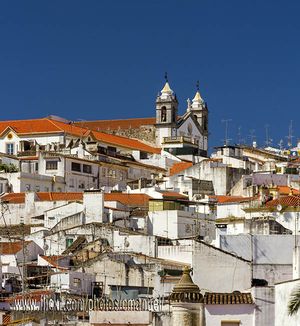
Elvas, Portugal
Enjoy a nice walk by the historical center of the city of Elvas and see its amazing walls and fortresses, in Alentejo, Portugal.
Elvas is a small and nice city, full of monuments, classified as World Heritage Site by UNESCO in 2012, due to its fortresses, which are the biggest and the best kept bastioned fortresses of the world; being an excellent example of fortress in Dutch style. In fact, Elvas is charming. It was a historical and strategic city that protected Portugal from a few steps of the enemy for centuries.
In Elvas it’s possible to see the Spanish city of Badajoz from any lookout. This is the reason why Elvas grew as the key of the kingdom, coming to have more than a hundred of military buildings.
This city also has Arabian ancestors. It was known as Lalbash from the 13th century until 1230, when it was taken by the Portuguese by theking D. Sancho II. The history of the city is full of war strategies and trade significance. Only Felipe II of Spain got the city in 1580 when Portugal lost the dependencies, situation that went on until the 1640. In those days, Felipe II lived in a beautiful palace in Elvas for some months, where he held his court and commanded the construction of the Cathedral and his Royal Chapel.
Elvas is an ideal scene to walk along the historical center and its fortresses with no direction in mind. The center is full of narrow streets that cross an endless number of charming squares. In each of its streets you’ll find a monument or a touristic point.
To better appreciate the fortresses, it is a good idea to go around its walls from the 17th century (5km.), and make a stop to see the two islamic walls, the doors, the moats and bastions of the 17th century.
Out of the historical center it’s possible to visit the Fortress of Santa Luzia (17th century), with a museological Military center, the magnificent Fortress da Graça (18th century) and three small forts built up by Wellington during the beginnings of 19th century.
You can access to the city center by any of its southern gates, where is located the Tourist office, the House of Culture, the former Paços do Concelho (16th century) and the amazing Cathedral of Elvas (Sé) that, just as the Paços do Concelho, was work of Francisco de Arruda, royal architect of D.Manuel I, who also built up the famous Tower of Bethlehem in Lisbon.
At the Sé-Cathedral it’s possible to visit the House of Canonry, transformed into Religious Art Museum with objects of the former bishopric of Elvas.
Leaving the Sé-Cathedral it’s possible to go up to Largo do Santa Clara, where you’ll find 4 monuments in a square: the first islamic wall (8th-9th centuries), the Pelourinho or pillory (16th century), the Palace of dos Mesquita Pimentel (refurbished by Juan de Herrera in the 16th century to welcome in Felipe II de España) and the Igreja das Dominicas Church (16th century), a beautiful church with octagonal floor and an interior fully of tiles and columns of marble painted with vegetables motifs.
Crossing under the first islamic wall, you can continue until the Lake of Acáçova, where it’s the Igreja da Santa María da Acaçova Church (13th century), former mosque. By the narrowest street of Elvas, on the left side of the church, you get to Rua das Beatas, a street of the former Judiaria Nova and after that you get to the Medieval Castle, opened to touristic visits.
Going down by the Rua das Flores street, you’ll get to the Headquarters da Corujeira (17th century), the Cemetery of the English (19th century), the Igreja de São João da Corujeira Church (13th century) and then to the Igreja dos Terceiros Church, with its important golden sculpture; and the Convent of Santa Clara, where it was created the traditional sweet of Elvas city: the Sericaia. You can continue going down from here to the Igreja de São Pedro Church and the Monastery of São Domingos (both of 13th century), or you can turn back to the Square by Rua dos Açougues street, where is located the Synagogue, transformed in a public place in the 16th century.
The visit to Elvas can’t conclude here. Outside the city you should visit the Aqueduct da Amoreira (16th-17th centuries) and the Capela do Senhor Jesus da Piedade Shrine (18th century) with the museum of votive offerings. Turning to the historical center it’s worth to walk by the streets where are located the Islamic Wall, the Municipal Library (inside a former Jesuit School of the 17th century), the Municipal Museum of Photography, the Military Museum of Elvas, The Contemporary Art Museum of Elvas, the Fernandina Tower (14th century) and a great variety of churches like: São Lourenço, Misericórdia, Salvador, Nossa Senhora da Nazaré, Nossa Senhora das Dores, Nossa Senhora da Conceição, São Martinho; as well as different military buildings like the House das Barcas, the Headquarter do Trem, the Headquarter do Assento, Paiol da Coinceição and, of course, the big Cisterna that supplied water to most fountains of the city.
Around the city, in direction to Olivença, you can visit the Igreja de Nossa Senhora da Ajuda Church and the Bridge da Ajuda (16th century), the last fortress-bridge of Europe.
Only 16 kilometres to the North-east of Elvas it’s located the town of Campo Maior with its Medieval Castle, the Igreja de São João Baptista Church, in which annexed chapel of the Carmo was placed a Religious Art Museum; and the Igreja de Nossa Senhora da Expectação Church (17th-18th centuries), that has annexed the gloomy Capela dos Ossos (Shrine Bones). It’s worth to visit the curious Coffee Museum and the Castle of Ouguela, too.
Mapa Interactivo:
Elvas
What to see:
- Amoreira Aqueduct
- Bastioned Fortifications
- Santa Luzia Fortress and Army Museum
- Graça Fort
- Elvas Cathedral
- Elvas Castle
- Cemitério dos Ingleses (English Cementery)
- Elvas Cultural Centre
- João Carpinteiro Photography Museum
- Elvas Contemporary Art Museum
- Largo de Santa Clara
- Church of São Domingos Convent
- Igreja da Ordem Terceira de São Francisco Church
- Santa Clara Convent
- São João de Deus Convent
Other worth-visiting nearby towns and cities:
Why "Portugal Travel"?
Portugal Travel is an organization of Portuguese agencies whose objectives are:
- ✓ To make Portugal, its culture and its heritage known.
- ✓ To promote sustainable tourism.
In collaboration with:
Escola Superior de Hotelaria e Turismo do Estoril
Turismo de Portugal
Copyright PortugalTravel.org © - All rights reserved.







